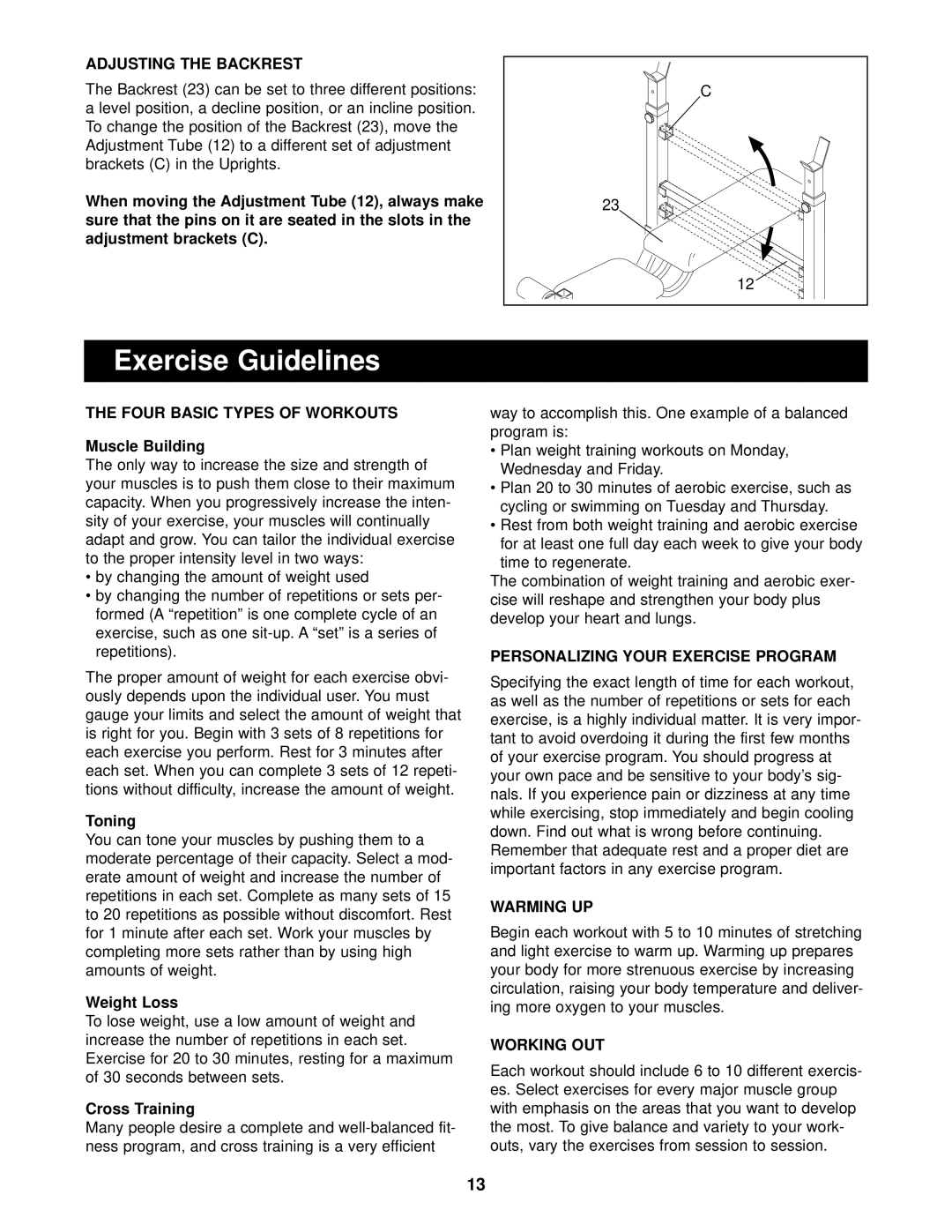
ADJUSTING THE BACKREST
The Backrest (23) can be set to three different positions: a level position, a decline position, or an incline position. To change the position of the Backrest (23), move the Adjustment Tube (12) to a different set of adjustment brackets (C) in the Uprights.
When moving the Adjustment Tube (12), always make sure that the pins on it are seated in the slots in the adjustment brackets (C).
Exercise Guidelines
THE FOUR BASIC TYPES OF WORKOUTS
Muscle Building
The only way to increase the size and strength of your muscles is to push them close to their maximum capacity. When you progressively increase the inten- sity of your exercise, your muscles will continually adapt and grow. You can tailor the individual exercise to the proper intensity level in two ways:
•by changing the amount of weight used
•by changing the number of repetitions or sets per- formed (A “repetition” is one complete cycle of an exercise, such as one
The proper amount of weight for each exercise obvi- ously depends upon the individual user. You must gauge your limits and select the amount of weight that
is right for you. Begin with 3 sets of 8 repetitions for each exercise you perform. Rest for 3 minutes after
each set. When you can complete 3 sets of 12 repeti- tions without difficulty, increase the amount of weight.
Toning
You can tone your muscles by pushing them to a moderate percentage of their capacity. Select a mod- erate amount of weight and increase the number of repetitions in each set. Complete as many sets of 15 to 20 repetitions as possible without discomfort. Rest for 1 minute after each set. Work your muscles by completing more sets rather than by using high
amounts of weight.
Weight Loss
To lose weight, use a low amount of weight and increase the number of repetitions in each set.
Exercise for 20 to 30 minutes, resting for a maximum of 30 seconds between sets.
Cross Training
Many people desire a complete and
C |
23 |
12 |
way to accomplish this. One example of a balanced program is:
•Plan weight training workouts on Monday, Wednesday and Friday.
•Plan 20 to 30 minutes of aerobic exercise, such as cycling or swimming on Tuesday and Thursday.
•Rest from both weight training and aerobic exercise for at least one full day each week to give your body time to regenerate.
The combination of weight training and aerobic exer- cise will reshape and strengthen your body plus develop your heart and lungs.
PERSONALIZING YOUR EXERCISE PROGRAM
Specifying the exact length of time for each workout, as well as the number of repetitions or sets for each exercise, is a highly individual matter. It is very impor- tant to avoid overdoing it during the first few months
of your exercise program. You should progress at your own pace and be sensitive to your body’s sig- nals. If you experience pain or dizziness at any time while exercising, stop immediately and begin cooling down. Find out what is wrong before continuing. Remember that adequate rest and a proper diet are important factors in any exercise program.
WARMING UP
Begin each workout with 5 to 10 minutes of stretching and light exercise to warm up. Warming up prepares your body for more strenuous exercise by increasing circulation, raising your body temperature and deliver- ing more oxygen to your muscles.
WORKING OUT
Each workout should include 6 to 10 different exercis- es. Select exercises for every major muscle group
with emphasis on the areas that you want to develop the most. To give balance and variety to your work- outs, vary the exercises from session to session.
13
